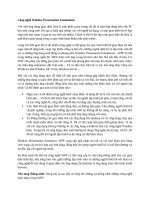triageonthewards presentation
Bạn đang xem bản rút gọn của tài liệu. Xem và tải ngay bản đầy đủ của tài liệu tại đây (104.31 KB, 16 trang )
Triage on the Wards
National Pediatric Nighttime Curriculum
Written by Becky Blankenburg, MD, MPH
Lucile Packard Children’s Hospital, Stanford
Objectives
1.
2.
3.
To refine your own system for triaging pages
and phone calls at night.
To identify ways of proactively improving your
triage abilities.
To help learners struggling with appropriately
triaging tasks.
Triage
Definition:
“A process for sorting injured [or sick] people into
groups based on their need for or likely benefit
from immediate medical treatment. Triage is
used in hospital emergency rooms, on
battlefields and disaster sites, [and at night]
when limited medical resources must be
allocated.”
- American Heritage Dictionary
Triage
Derived from the French word trier,
meaning “to sort”
First used by the chief surgeon of
Napoleon’s army (Dominique-Jean Larrey)
in the early 19th century
First published report of
civilian ED triage in 1966
Case 1
You are the intern on-call and simultaneously receive the
following 5 pages. How do you prioritize them? What
do you do?
1.
“Josh has bad abdominal pain.”
2.
“Sophia’s mom just arrived from work and would like to
hear how she is doing.”
3.
“Dr. Smith (Zach’s private physician) just called and is
upset that you didn’t start him on Ceftriaxone. He
would like a call back immediately.”
4.
“Molly [12 with pre-B cell ALL just admitted with fever
and neutropenia] has a blood pressure that’s 70/30.”
5.
“Alex is breathing harder. Would like to start Albuterol.”
General Principles to Improve Ability to
Triage on the Wards
What do you do?
How can you help others improve their
ability to triage?
General Principles to Improve Ability to
Triage on the Wards
Get good sign-out
Check on sicker patients at beginning of
shift
Anticipate how patients will get sicker and
what you will do in response
Look/ask for trends
Trends in vitals, trends in pain, etc
General Principles to Improve Ability to
Triage on the Wards cont
Check-in with each other
Know your resources ahead of time
(physicians in-hospital (and outside),
nurses, respiratory therapists, etc)
General Principles to Improve Ability to
Triage on the Wards cont
Communicate delays/concerns to your
attending
Some
delays can lead to poor patient
outcomes (and your attendings can be helpful
mobilizing resources, if they know)
Communicate delays to families and
nurses (when possible)
Most
people are remarkably understanding if
they just have appropriate expectations
Case 2
You are the nighttime senior resident and receive several
calls from nurses that they are concerned that your
intern isn’t returning her pages. You have noticed that
your intern tends to have a “deer in the headlights”
look when receiving new information and has a hard
time multitasking.
What can you do to help your intern prioritize and
multitask?
How to Help Learners Who Are
Having a Hard Time Triaging
Share organizational strategies with the intern.
Practice making “To Do” lists.
Discuss how quickly pages need to be returned.
Discuss how helpful it can be to set appropriate
expectations.
eg, “It will take me an hour to review that
chest x-ray.”
Discuss strategies for triaging duties (as
discussed on prior slides).
Check in with the intern periodically.
When to Escalate Care:
Calling Rapid Responses or Codes
What’s the difference between Rapid Response
Teams and Code Teams?
Varies from hospital to hospital
General differences include
Different team members
Different response times
Rapid Response Teams
Rapid Response Teams are usually
composed of one of the following groups:
PICU RN and RT
PICU RN, RT, PICU Attending/Fellow
PICU RN, RT, Hospitalist Attending/Fellow
PICU RN, RT, PA
Slightly Slower Response
Time
Code Teams
Code Teams usually include all of the
following:
PICU Attending/Fellow or Hospitalist
PICU RN
PICU RT
+/- Pharmacist
Faster Response Time
Take Home Points
1.
2.
3.
4.
Take proactive steps to aid you in triaging
pages and phone calls at night.
Pay attention to the learners you are
supervising and help them to appropriately
triage their tasks.
Know who and what your resources are at
night.
Remember that there is always back-up – even
if it means bringing in a fellow or attending
from home.
References
Schmitt BD, Thompson DA. Triage Documentation:
Setting a Best Practice.
2005.
Sharek P, et al. Effective of a Rapid Response Team
on Hospital-wide Mortality and Code Rates Outside
the ICU in a Children’s Hospital. JAMA, 298(19):
2267-2274, 2007.
Thompson T, Stanford K, Dick R, Graham J. Triage
Assessment in Pediatric Emergency Departments: A
National Survey. Ped Em Care, 26(8):544-548, 2010.









